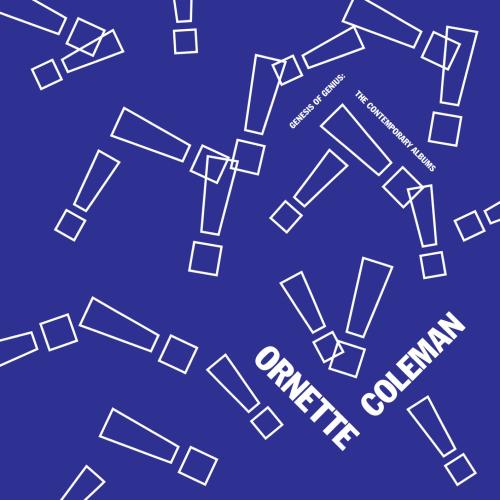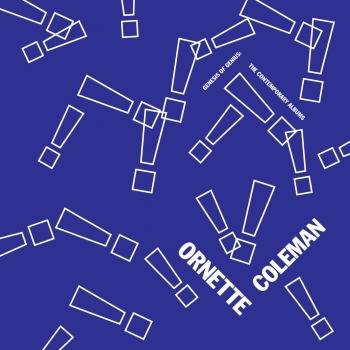
Genesis of Genius: The Contemporary Recordings (Remastered) Ornette Coleman
Album Info
Album Veröffentlichung:
2021
HRA-Veröffentlichung:
25.03.2022
Das Album enthält Albumcover
Entschuldigen Sie bitte!
Sehr geehrter HIGHRESAUDIO Besucher,
leider kann das Album zurzeit aufgrund von Länder- und Lizenzbeschränkungen nicht gekauft werden oder uns liegt der offizielle Veröffentlichungstermin für Ihr Land noch nicht vor. Wir aktualisieren unsere Veröffentlichungstermine ein- bis zweimal die Woche. Bitte schauen Sie ab und zu mal wieder rein.
Wir empfehlen Ihnen das Album auf Ihre Merkliste zu setzen.
Wir bedanken uns für Ihr Verständnis und Ihre Geduld.
Ihr, HIGHRESAUDIO
- 1 Invisible 04:12
- 2 The Blessing 04:45
- 3 Jayne 07:17
- 4 Chippie 05:37
- 5 The Disguise 02:48
- 6 Angel Voice 04:18
- 7 Alpha 04:12
- 8 When Will The Blues Leave? 04:56
- 9 The Sphinx 04:14
- 10 Tomorrow Is The Question! 03:09
- 11 Tears Inside 05:00
- 12 Mind And Time 03:08
- 13 Compassion 04:37
- 14 Giggin' 03:19
- 15 Rejoicing 04:04
- 16 Lorraine 05:55
- 17 Turnaround 07:55
- 18 Endless 05:18
Info zu Genesis of Genius: The Contemporary Recordings (Remastered)
Continuing Contemporary Records’ 70th anniversary celebration, Craft Recordings is proud to announce the release of the double album, "Ornette Coleman – Genesis of Genius: The Contemporary".
Largely avoided by his colleagues on the L.A. jazz scene in the late 1950s, Coleman (March 9, 1930 – June 11, 2015) found an open door at Contemporary Records, where the label’s founder Lester Koenig was intrigued by his melodic sensibility and unorthodox approach to phrasing. After his Contemporary albums, Coleman quickly went on to New York City and turned the jazz scene on its head, but it was Koenig who provided the first glimpse of the saxophonist’s new approach to rhythm and harmony.
“These two recordings are the accessible gateway to Ornette Coleman’s music,” says Nick Phillips, the producer of Genesis of Genius. “He’s expanding on the bebop vocabulary and at this point he’s using traditional forms for most compositions, 12-bar blues and AABA song form, but doing something totally different. With Ornette and Don Cherry’s trumpet in the front line, the way they play and phrase and shift rhythms together, it sounds very loose but very tight.”
Featuring Coleman’s working band with Don Cherry on trumpet, pianist Walter Norris, bassist Don Payne and drummer Billy Higgins, the album Something Else!!!! sounds less radical today than strikingly individual and steeped in the blues. With nine Coleman originals, the session introduced several tunes that became standards, including “The Blessing” and “When Will the Blues Leave?” Featuring Cherry, Shelly Manne, and either Percy Heath or Red Mitchell on bass, the emphatic, piano-less follow up Tomorrow Is the Question! made it clear that Coleman’s concepts were both insistently innovative and tethered to bedrock African American idioms. Consisting entirely of Coleman originals, the album introduced several more tunes that became an essential part of the jazz canon, including “Tears Inside,” “Rejoicing” and “Turnaround.”
More than a seminal improviser and composer who exponentially expanded jazz’s rhythmic and harmonic frontiers, Coleman embodied the playfully heroic duality-erasing ideal at the center of African American musical innovation. Radical and rootsy, avant-garde and populist, philosophical and visceral, genius and trickster, Coleman was born and raised in Ft. Worth, and the wailing Texas blues was woven into his sound. By the time he settled in Los Angeles in the mid-1950s he’d spent years on the road playing blues and R&B, imbuing a gutbucket sensibility that he carried with into every musical setting.
L.A. beboppers often treated him with disdain, perceiving his unorthodox note choice as lack of chops, but he slowly found a brilliant cadre of musicians who embraced his musical vision, including pianist Paul Bley, drummers Billy Higgins and Eddie Blackwell, bassist Charlie Haden and Don Cherry. The Contemporary albums paved the way for Coleman’s fall 1959 triumph in New York City, with Tomorrow Is the Question! hitting stores the same month that his quartet started an extended run at the Five Spot, arguably the most consequential and controversial gig in jazz history.
Alternately championed and denounced by his musical peers and critics, Coleman found a new home at Atlantic Records, where he continued expanding his gorgeous, searing, utterly human approach to music. But it was Lester Koenig who first recognized Coleman’s genius when he walked into his Melrose office at a time when the saxophonist wasn’t even welcome on most bandstands.
Something Else:
Ornette Coleman, alto saxophone
Don Cherry, trumpet
Walter Norris, piano
Don Payne, double bass
Billy Higgins, drums
Tomorrow Is the Question:
Ornette Coleman, alto saxophone
Don Cherry, trumpet
Percy Heath, double bass (tracks 1-6)
Red Mitchell, double bass (7-9)
Shelly Manne, drums
Digitally remastered by Bernie Grundman
Ornette Coleman
One of the most important (and controversial) innovators of the jazz avant-garde, Ornette Coleman gained both loyal followers and lifelong detractors when he seemed to burst on the scene in 1959 fully formed. Although he, and Don Cherry in his original quartet, played opening and closing melodies together, their solos dispensed altogether with chordal improvisation and harmony, instead playing quite freely off of the mood of the theme. Coleman's tone (which purposely wavered in pitch) rattled some listeners, and his solos were emotional and followed their own logic. In time, his approach would be quite influential, and the quartet's early records still sound advanced many decades later.
Unfortunately, Coleman's early development was not documented. Originally inspired by Charlie Parker, he started playing alto at 14 and tenor two years later. His early experiences were in R&B bands in Texas, including those of Red Connors and Pee Wee Crayton, but his attempts to play in an original style were consistently met with hostility both by audiences and fellow musicians. Coleman moved to Los Angeles in the early '50s, where he worked as an elevator operator while studying music books. He met kindred spirits along the way in Don Cherry, Charlie Haden, Ed Blackwell, Bobby Bradford, Charles Moffett, and Billy Higgins, but it was not until 1958 (after many unsuccessful attempts to sit in with top L.A. musicians) that Coleman had a nucleus of musicians who could play his music. He appeared as part of Paul Bley's quintet for a short time at the Hillcrest Club (which is documented on live records), and recorded two very interesting albums for Contemporary. With the assistance of John Lewis, Coleman and Cherry attended the Lenox School of Jazz in 1959, and had an extended stay at the Five Spot in New York. This engagement alerted the jazz world toward the radical new music, and each night the audience was filled with curious musicians who alternately labeled Coleman a genius or a fraud.
During 1959-1961, beginning with The Shape of Jazz to Come, Coleman recorded a series of classic and startling quartet albums for Atlantic. With Don Cherry, Charlie Haden, Scott LaFaro, or Jimmy Garrison on bass, and Billy Higgins or Ed Blackwell on drums, Coleman created music that would greatly affect most of the other advanced improvisers of the 1960s, including John Coltrane, Eric Dolphy, and the free jazz players of the mid-'60s. One set, a nearly 40-minute jam called Free Jazz (which other than a few brief themes was basically a pulse-driven group free improvisation) had Coleman, Cherry, Haden, LaFaro, Higgins, Blackwell, Dolphy, and Freddie Hubbard forming a double quartet.
In 1962, Coleman, feeling that he was worth much more money than the clubs and his label were paying him, surprised the jazz world by retiring for a period. He took up trumpet and violin (playing the latter as if it were a drum), and in 1965, he recorded a few brilliant sets on all his instruments with a particularly strong trio featuring bassist David Izenzon and drummer Charles Moffett. Later in the decade, Coleman had a quartet with the very complementary tenor Dewey Redman, Haden, and either Blackwell or his young son Denardo Coleman on drums. In addition, Coleman wrote some atonal and wholly composed classical works for chamber groups, and had a few reunions with Don Cherry.
In the early '70s, Coleman entered the second half of his career. He formed a 'double quartet' comprised of two guitars, two electric bassists, two drummers, and his own alto. The group, called 'Prime Time,' featured dense, noisy, and often-witty ensembles in which all of the musicians are supposed to have an equal role, but the leader's alto always ended up standing out. He now called his music harmolodics (symbolizing the equal importance of harmony, melody, and rhythm), although free funk (combining together loose funk rhythms and free improvising) probably fits better; among his sidemen in Prime Time were drummer Ronald Shannon Jackson and bassist Jamaaladeen Tacuma, in addition to his son Denardo. Prime Time was a major (if somewhat unacknowledged) influence on the M-Base music of Steve Coleman and Greg Osby. Pat Metheny (a lifelong Ornette admirer) collaborated with Coleman on the intense Song X, Jerry Garcia played third guitar on one recording, and Coleman had irregular reunions with his original quartet members in the 1980s.
Coleman, who recorded for Verve in the '90s, has remained true to his highly original vision throughout his career and, although not technically a virtuoso and still considered controversial, is an obvious giant of jazz. He recorded sparingly as the 21st century began, appearing on Joe Henry's Scar in 2000 and on single tracks on Lou Reed's Raven and Eddy Grant's Hearts & Diamonds, both released in 2002. (Scott Yanow) Source: Blue Note Records
Dieses Album enthält kein Booklet







